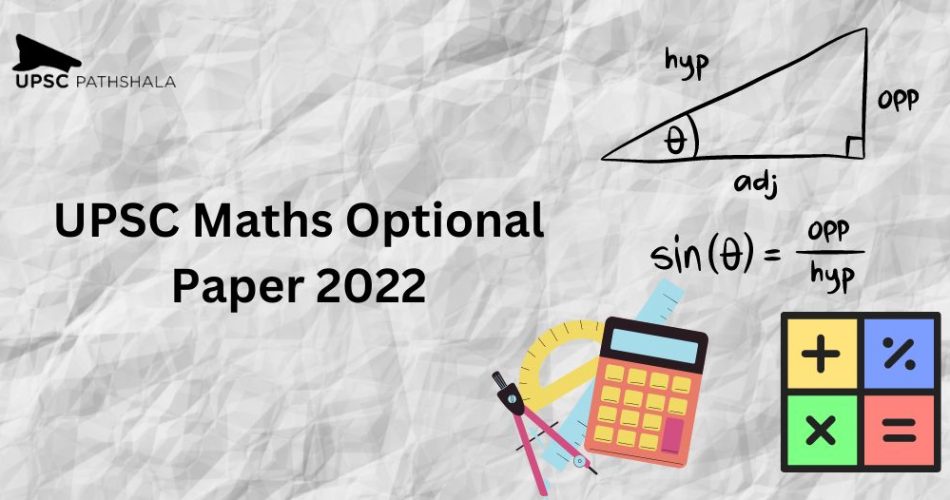If you are preparing for the UPSC exam, the UPSC maths optional paper 2022 is given in this article so that you can start your civil service preparation perfectly to score better.
Also Read: Environment and Ecology Questions and Solutions: UPSC Prelims 2019
UPSC Mains 2022 Mathematics Optional Question Paper
The UPSC CSE mains 2022 maths paper consists of the questions from the syllabus given below. Let’s dive into the syllabus to prepare for the UPSC main exam paper. For even better preparation do visit best classes for UPSC, that is the UPSC Pathshala.
Paper – I
#1 Linear Algebra: Vector spaces over R and C, linear dependence and independence, subspaces, bases, dimension; linear transformations, rank and nullity, matrix of a linear transformation. Algebra of Matrices; row and column reduction, echelon form, congruence, and similarity; the rank of a matrix; the inverse of a matrix; solution of a system of linear equations; eigenvalues and eigenvectors, characteristic polynomial, Cayley-Hamilton theorem, symmetric, skew-symmetric, Hermitian, skew-Hermitian, orthogonal and unitary matrices, and their eigenvalues.
#2 Calculus: Real numbers, functions of a real variable, limits, continuity, differentiability, mean value theorem, Taylor’s theorem with remainders, indeterminate forms, maxima and minima, asymptotes; curve tracing; functions of two or three variables: limits, continuity, partial derivatives, maxima, and minima, Lagrange’s method of multipliers, Jacobian. Riemann’s definition of definite integrals; indefinite integrals; infinite and improper integrals; double and triple integrals (evaluation techniques only); areas, surface, and volumes.
#3 Analytic Geometry: Cartesian and polar coordinates in three dimensions, second-degree equations in three variables, reduction to canonical forms, straight lines, the shortest distance between two skew lines; plane, sphere, cone, cylinder, paraboloid, ellipsoid, hyperboloid of one and two sheets and their properties.
#4 Ordinary Differential Equations: Formulation of differential equations; equations of the first order and first degree, integrating factor; orthogonal trajectory; equations of first order but not of the first degree, Clairaut’s equation, singular solution. Second and higher order linear equations with constant coefficients, complementary function, particular integral, and general solution.
Second-order linear equations with variable coefficients, Euler-Cauchy equation; determination of complete solution when one solution is known using the method of variation of parameters. Laplace and inverse Laplace transforms and their properties; Laplace transforms of elementary functions. Application to initial value problems for 2nd order linear equations with constant coefficients.
#5 Dynamics & Statics: Rectilinear motion, simple harmonic motion, motion in a plane, projectiles; constrained motion; work and energy, conservation of energy; Kepler’s laws, orbits under central forces. Equilibrium of a system of particles; work and potential energy, friction; common catenary; the principle of virtual work; stability of equilibrium, equilibrium of forces in three dimensions.
#6 Vector Analysis: Scalar and vector fields, differentiation of vector field of a scalar variable; gradient, divergence and curl in cartesian and cylindrical coordinates; higher order derivatives; vector identities and vector equations. Application to geometry: curves in space, curvature, and torsion; Serret-Frenet’s formulae. Gauss and Stokes’ theorems, Green’s identities.
Also Read: Solved UPSC Prelims 2012 Environment Subject Questions : Crack the UPSC Exam!
UPSC Mains 2022 Mathematics Optional Question Paper
Paper-II
#1 Algebra: Groups, subgroups, cyclic groups, cosets, Lagrange’s Theorem, normal subgroups, quotient groups, homomorphism of groups, basic isomorphism theorems, permutation groups, Cayley’s theorem. Rings, subrings and ideals, homomorphisms of rings; integral domains, principal ideal domains, Euclidean domains, and unique factorization domains; Fields, quotient fields.
#2 Real Analysis: Real number system as an ordered field with the least upper bound property; sequences, the limit of a sequence, Cauchy sequence, completeness of real line; Series and its convergence, absolute and conditional convergence of series of real and complex terms, rearrangement of series. Continuity and uniform continuity of functions, properties of continuous functions on compact sets.
Riemann integral, improper integrals; fundamental theorems of integral calculus. Uniform convergence, continuity, differentiability, and integrability for sequences and series of functions; partial derivatives of functions of several (two or three) variables, maxima, and minima.
#3 Complex Analysis: Analytic functions, Cauchy-Riemann equations, Cauchy’s theorem, Cauchy’s integral formula, power series representation of an analytic function, Taylor’s series; singularities; Laurent’s series; Cauchy’s residue theorem; contour integration.
#4 Linear Programming: Linear programming problems, basic solution, basic feasible solution, and optimal solution; graphical method and simplex method of solutions; duality. Transportation and assignment problems.
#5 Partial differential equations: Family of surfaces in three dimensions and formulation of partial differential equations; solution of quasilinear partial differential equations of the first order, Cauchy’s method of characteristics; Linear partial differential equations of the second order with constant coefficients, canonical form; equation of a vibrating string, heat equation, Laplace equation, and their solutions.
#6 Numerical Analysis and Computer programming: Numerical methods: solution of algebraic and transcendental equations of one variable by bisection, Regula-Falsi, and Newton-Raphson methods; solution of a system of linear equations by Gaussian elimination and Gauss-Jordan (direct), Gauss-Seidel(iterative) methods. Newton’s (forward and backward) interpolation, Lagrange’s interpolation.
Numerical integration: Trapezoidal rule, Simpson’s rules, Gaussian quadrature formula. Numerical solution of ordinary differential equations: Euler and Runge Kutta-methods. Computer Programming: Binary system; Arithmetic and logical operations on numbers; Octal and Hexadecimal systems; Conversion to and from decimal systems; Algebra of binary numbers.
Elements of computer systems and concept of memory; Basic logic gates and truth tables, Boolean algebra, normal forms. Representation of unsigned integers, signed integers and reals, double precision reals, and long integers. Algorithms and flow charts for solving numerical analysis problems.
#7 Mechanics and Fluid Dynamics: Generalized coordinates; D’ Alembert’s principle and Lagrange’s equations; Hamilton equations; Moment of inertia; Motion of rigid bodies in two dimensions. Equation of continuity; Euler’s equation of motion for inviscid flow; Stream-lines, the path of a particle; Potential flow; Two-dimensional and axisymmetric motion; Sources and sinks, vortex motion; Navier-Stokes equation for a viscous fluid.
Also Read: Polity Questions in UPSC Prelims 2016: Learn and Prepare with the Solved Exam Paper
Conclusion
Therefore, visit the UPSC Pathshala, the best classes for UPSC to get more content and tips for your UPSC main exam paper and boost your civil service preparation.







